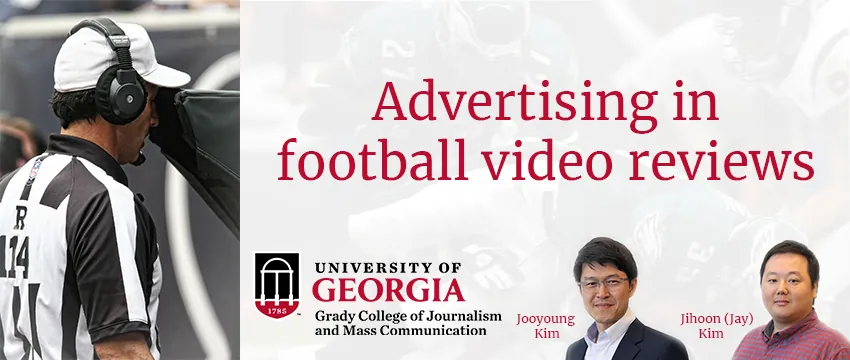Football fans like brands more when sponsored replays help their favorite team

Football fans like brands more when sponsored replays help their favorite team
The result of football instant replay video reviews can
alter a consumer’s perception of a brand, according to a study conducted by
researchers at the University of Georgia Grady College of Journalism and Mass
Communication.
The
upcoming Super Bowl, often referred to as the “Ad Bowl,” provides a variety of
advertising opportunities, including when officials pause game action to
analyze an Instant Replay Video.
A pair of
Grady College researchers have linked the outcomes of those football replay
reviews to consumers having a positive perception of a brand.
Jihoon “Jay”
Kim, a doctoral student at Grady College, and Jooyoung Kim, an associate professor
of advertising, investigated how the use of advertising in sporting events’
replay review affected consumer feelings toward sponsored brands.
“I watched
a tennis game one day and saw the replay system,” Jay Kim said. “While the
video was reviewed live, I saw a brand logo on the screen and thought it was
interesting because two groups of fans were watching it; the result of the
replay video would make one group happy and the other group unhappy.”
To untap
this psychological phenomenon, they researched the concept of “schadenfreude,”
a German word for the experience of joy when observing another’s misfortune, or
in this case, the joy fans have when a referee makes a call that helps their
team and hurts the opponent.
“An
advertisement used correctly can have a positive emotional transfer to a
consumer,” Jooyoung Kim said. “A traditional view is that attitudes toward
advertising leads to attitudes toward the brand, which then drives consumer
behavior.”
Jay Kim
and Jooyoung Kim developed an online experiment where nearly 400 students
watched brand-sponsored IRVs in college football games. Participants were then asked
a series of questions based on the result of the replay review.
The study
measured responses in four game situations varied by the caliber of rivalry and
level of suspense: rivalry games, non-rivalry games, suspenseful games and
non-suspenseful games.
Results
showed increased focus and attention from spectators during rivalry games and
during suspenseful moments. Also, spectators felt a greater amount of positive
emotion when a referee’s decision through an IRV benefited their team late in a
game with a close score compared to a less suspense-filled moment.
Jooyoung
Kim said the results of this study could lead to a series of exciting
advancements for advertisers of sporting events.
“Advertisers
want to be present at the place where their audiences are happy rather than mad.
They want to be associated with the positive memory,” Jooyoung Kim said.
According
to Jooyoung Kim, in the past it was not possible to understand an audience down
to the individual level. Individual targeting is becoming possible because of
the technological advances. Programming systems will be able to use algorithms
to choose whether to show a certain brand logo to a specific fan watching the
game. The typical broadcast delay of approximately seven seconds for
live-streaming sporting events will enable marketers to tailor the brand logo
to match the happy fan.
“In an
international competition such as FIFA World Cup or the Wimbledon
Championships, sponsoring brands could use geographical information to decide whether
their ads should be used with an IRV based on whether the outcome benefits a
particular team or player. This would need a lot of coordination among the
sponsors, media, and the sporting event hosts,” Jay Kim added.
Future
research will focus on schadenfreude’s inverse concept, gluckschmerz, or
feeling unhappy about the good fortune of others.
“Both
concepts show how morally weak humans can be in social settings: we like when our
opponent fails and don’t like when the opponent succeeds. But that’s the
reality of being human, and the marketers can seize this untapped opportunity
for their brands,” Jooyoung Kim said.